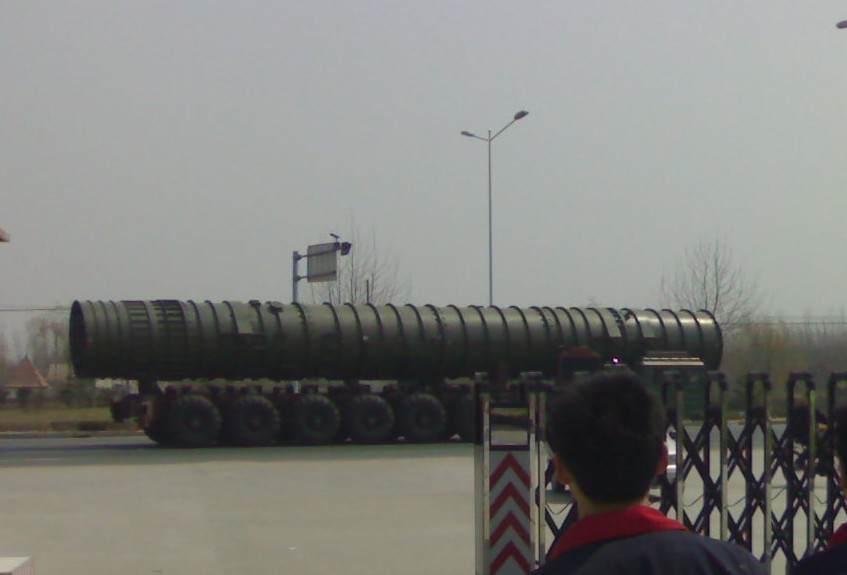 
 字體:小 中 大
字體:小 中 大 |
|
|
|
| 2013/05/29 21:29:42瀏覽805|回應0|推薦1 | |
最新東風-41 解析
據俄羅斯“Dragonsart”網站 The Dongfeng-41 (DF-41, CSS-X-10) (Chinese: 东风-41; literally "East Wind"), is a Chinese nuclear solid-fueled road-mobile intercontinental ballistic missile.
東風-41型洲際彈道飛彈(DF-41,北約代號CSS-X-10)是中華人民共和國正在開發或已服役的固體燃料洲際彈道飛彈,可攜帶大約10枚分導式多彈頭,性能類似美國MX和平守護者洲際彈道飛彈,最大射程14,000公里,從中國大陸發射可覆蓋大部分國家。 此前還有媒體報導稱,中國上個月還曾成功試射了陸基“東風 - “東風 中國以前沒有這種類型的導彈,“東風 印度衛星發現青海驚人一幕:中國東風41大批服役 印度防務評估網站 現在射程在4000至 文章指出,隨著中國武庫的擴大與現代化,以及核儲備計畫的推進,本世紀西藏的戰略價值只會進一步升級。2008年一項分析稱,衛星圖片分析結果顯示,在中國面積達2000平方公里的地區,分散部署著50多個核彈道導彈發射場。這說明解放軍在青海省北部地方德令哈和大柴旦地區部署在核力量要以往所知規模更大。 文章稱,在過去十年裏,中國導彈已從液體燃料導彈發展至固體燃料導彈,而且增加了機動發射裝置的部署,縮短了“行動”時間。早在2006年的時候,就有報導稱東風-21導彈部署在德令哈和大柴旦地區。 中國已經在青藏高原建成了14個大型空軍基地,以及一系列戰術跑道。一旦與印度有戰事發生,這些基地就可使中國空軍控制西藏空域與前沿陣地,並能夠針對印度北部地方展開持久空戰,攻擊所有印度北部城市,包括新德里、孟買地區。 文章表示,中國在青藏高原的電子情報能力,也賦予了其在任何空戰中獲得作戰資訊與戰鬥管理的重要優勢。西藏地區的高海拔機場,不利於解放軍空軍針對印度展開有限的空戰行動。不過,如今解放軍空軍已經通過延長跑道(10000至 文章最後稱,除大規模解放軍軍事存在之外,這裏還有5個已知導彈基地、至少88枚洲際彈道導彈、70枚中程導彈以及20枚中遠端導彈。 中國東風41大殺器五大超強性能大揭秘 “東風
The Dongfeng missile is a series of intermediate and intercontinental ballistic missiles operated by the People's Republic of China. Typically, the word Dongfeng is shortened to "DF". China's Dongfeng missile is considered by some to be a "game-changer". With an effective range of around 900 miles, this missile was designed to “KILLl" aircraft carriers, but what more could it do if it were based on one?
1、東風-41之所以能夠震撼美國,是因為它的能力已經足以覆蓋美國全境; 2、“東風 3、“東風 4、“東風 5、“東風 由此可見,東風-41確實是中國又一種“驚天大殺器”。這對於中國的國防建設、提高中國戰略威懾力來說起著舉足輕重的作用。之所以對於是否與中國發生戰爭的考量中,懼於中國的國防力量,他們也不敢輕舉妄動。 Dong Feng 41, also known as DF-41 and CSS-10 East Wind, is an Intercontinental Ballistic Missile (ICBM) evolved from the DF-31 featuring an enlarged third stage to achieve an improved range of 12,000 km. It will be armed with a single 1 Megaton yield nuclear warhead but a DF-41 MIRVed (multiple warheads) may be possible as well.
The DF-41 ballistic missile will retain the DF-31 road mobile feature for enhanced survivability. Its extended range will provide China capability to target the whole United States, Europe, Asia and Africa territories. About 50-100 DF-41s fielded by 2015 seems to be likely. DF-41s will complement DF-31 ballistic missiles in the land-based Chinese nuclear arsenal.
The Chinese are believed to have started the design and development of the Dong Feng-41 (DF-41) in 1986, with the operational requirement to have a solid-propellant, road mobile, ballistic missile with a range of 12,000 km to replace the CSS-4 (DF-5 and DF-5A) liquid-propellant missiles. The development for DF-41 is believed to be managed by the China Aerospace Sciences and Industry Corporation (CASIC), Beijing (it was the First Academy of the Ministry of Aerospace Industries).
The flight test programme is managed by the 2nd Artillery Corps, based at the Wuzhai test centre in Shanxi province. There has been one reported ground test and a simulated cold launch in October 1999, but no test flights to date, although a test was reported to have been in preparation in September 2001. Original reports stated that DF-41 used the first two stages of the DF-31, with a lengthened third stage, but it is now believed that this description referred to the DF-31A, and that the DF-41 is a new design. It is believed that the NATO designator is CSS-X-10.
Reports in 1996 suggested that DF-41 would have between two and nine MIRV warheads, but it is possible that the initial build missiles will have provision for either a single warhead or up to 10 MIRV. In 2001 both rail-car and cross-country Transporter-Erector-Launcher (TEL) projects were noted for DF-31, and it is presumed that these might also be adapted later for DF-41. These launchers appeared to use a rail-car similar to that used with DF 31.
http://youtu.be/06PruJthsdk |
|
| ( 時事評論|國防軍事 ) |







![The photo widely disseminated on the Internet shows a missile said to be possibly China’s intercontinental ballistic missile DF-41. According to a report published on freebeacon.com, China just tested the missile DF-41 on July 24, 2012. Details of the missile are still unknown.[Internet photo] The photo widely disseminated on the Internet shows a missile said to be possibly China’s intercontinental ballistic missile DF-41. According to a report published on freebeacon.com, China just tested the missile DF-41 on July 24, 2012. Details of the missile are still unknown.[Internet photo]](http://images.china.cn/attachement/jpg/site1007/20120822/001372acd0b5119eda700c.jpg)













